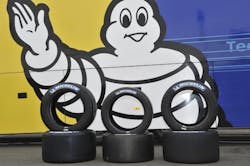For Michelin, the wide array of promising new cars entered in the 2012 American Le Mans Series (ALMS) and the 24 Hours of Le Mans can only mean one thing-more learning opportunities than ever. New tires, more dimensions and fresh challenges are everywhere as one of the world’s premier tire makers looks to extend its record of success in endurance racing and specifically the ALMS.
In 2012, Michelin is seeking a 14th consecutive overall win at the Twelve Hours of Sebring and Petit Le Mans and an unprecedented 15th win in a row at the 24 Hours of Le Mans.New cars and new rules for 2012 provide an opportunity to explore new tire dimensions.
“Designers and car-makers come to Michelin earlier and earlier in the design phase to help identify the ideal tire dimensions and performance priorities,” said Karl Koenigstein, Michelin North America motorsports technical team leader. “It takes time to consider new dimensions, create designs and constructions, run simulation, and produce a new size. From the team view, new dimensions, especially taller tires, require adjustments in suspension set-ups to compensate for the increased ride height of the taller front tire.”
Unlike many racing series, the ALMS and the new FIA World Endurance Championship (WEC) encourage open competition for tire makers, as opposed to a spec tire series. Rather than a one-tire-fits-all approach, tire makers can work closely with manufacturers and teams to develop specific tire shapes and sizes to optimize performance within a maximum dimensional boundary. Like passenger car tires for everyday application, tire sizing in motorsports is critical to optimize the car’s performance.
Michelin is currently developing new tire constructions, compounds and/or dimensions for Audi, Toyota, Rebellion, Muscle Milk HPD and the radical new DeltaWing, plus GT entries from Corvette, Porsche and Ferrari. In addition, Michelin is developing tires for the Audi and Toyota hybrid prototypes and the third-generation Porsche 911 GT3R Hybrid.
“Each development program presents a new technical change and allows us to stretch the limits of what is possible for tire design. There is certainly a lot going on and the excitement is building leading up to Sebring” said Silvia Mammone, Michelin motorsports manager and global project leader for Michelin on the DeltaWing project.
“The Corvette is a front-engine car, the Ferrari is mid-engine and the Porsche is rear-engine. The Corvette front tires have a much greater load than the Porsche front tires, and the Ferrari is another combination, so why should all three run the same tire solution?” asks Michelin’s Koenigstein, “At Michelin we want to optimize a vehicle’s performance, not constrain it.”
The 2012 Michelin technical partner GT teams from Flying Lizard Porsche and Corvette Racing, as well as the Extreme Speed Motorsports Ferraris, will race new 1.2 inch taller front Michelin tires in 2012.
While wider tires mean more contact with the road and increased grip, slightly taller tires can handle more energy, lengthen the contact patch under braking and help extend tire wear by spreading the load over a greater area. The taller tires also help broaden the range for car set-ups, according to Michelin.
The most dramatic example of tire dimensions can be found on the special Michelin tires developed for the radical DeltaWing Le Mans car. While Audi and other top prototypes pushed the front tire width to the extremes (14.2 inches wide by 28 inches tall), the MICHELIN front tires for the DeltaWing measure just four inches wide!
“The DeltaWing is an exciting opportunity to explore what happens in a very different direction,” said Mammone. “The car has half the power, weight, and fuel and uses an unconventional design. It is a great chance for us to see how to maintain performance with extremely varied tires.”
For more information, visit www.MichelinAlley.com



